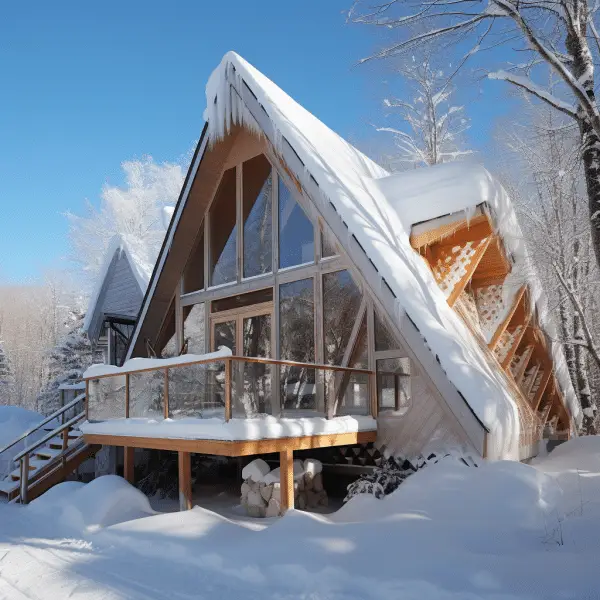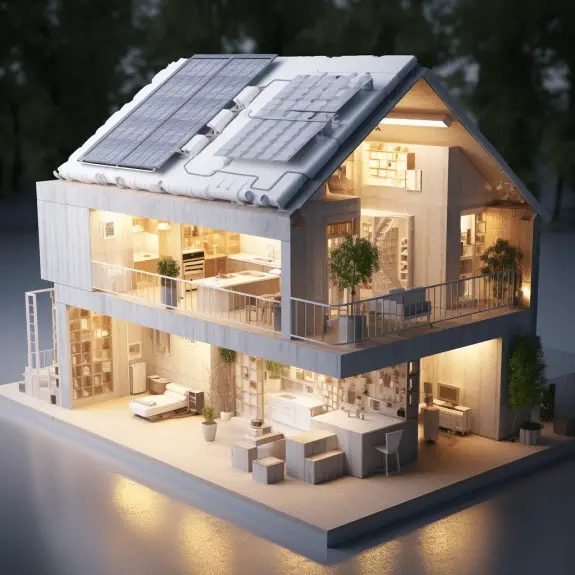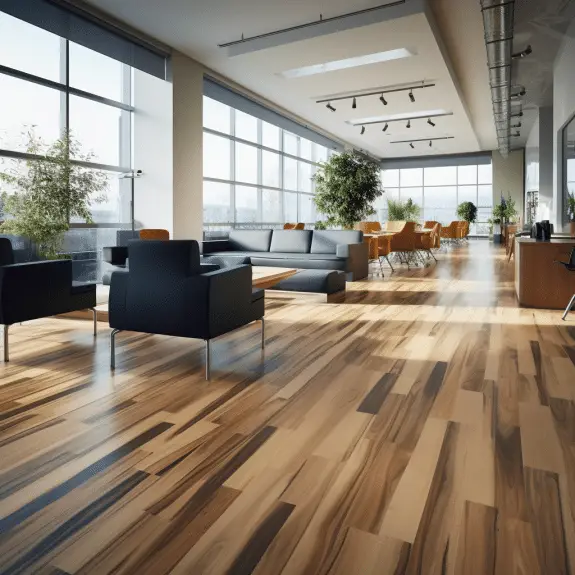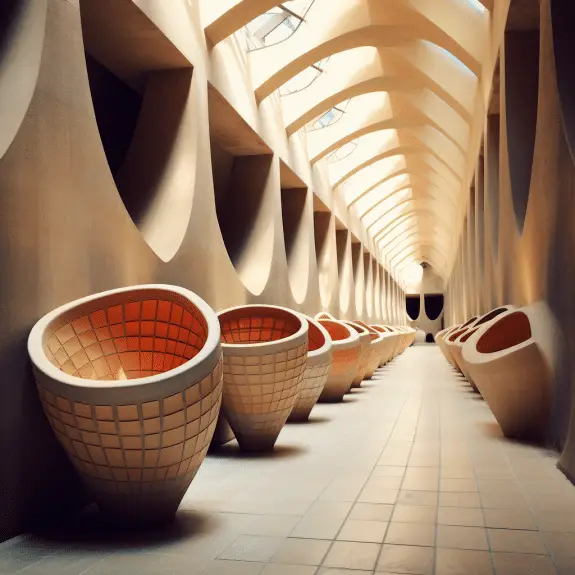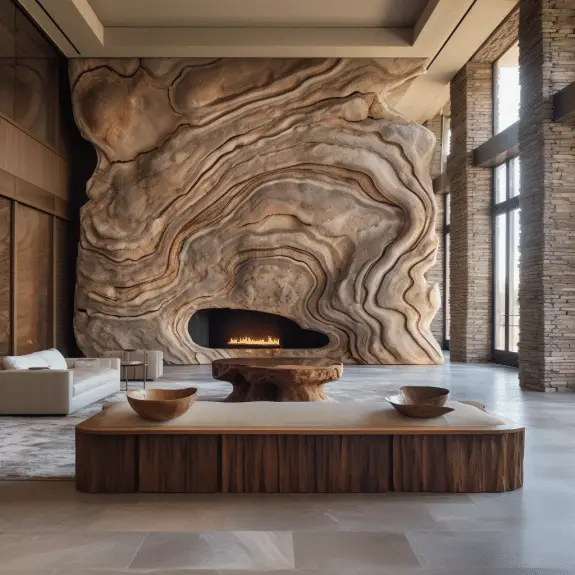Selecting Building Materials for Cold Climates
In cold climates, it’s crucial to choose building materials that are both durable and energy-efficient. The right materials can help maintain a warm and comfortable home while also saving on energy costs. Here are some excellent building materials to consider, along with key factors to keep in mind when selecting materials for cold climates.
Key Takeaways:
- Cold climate building materials should be both durable and energy-efficient.
- Brick, stone, concrete, plastic, wood, and metal are suitable choices for cold climates.
- Consider factors like insulation, foundation strength, windows, and roofing when selecting materials.
- Energy-efficient windows and proper insulation are essential for maintaining a comfortable temperature.
- Choose roofing materials that can withstand heavy snow and prevent leaks.
Brick: A Durable and Insulating Building Material for Cold Climates
When it comes to building in cold climates, selecting the right materials is essential. One such material that stands out for its durability and insulating properties is brick. Brick has been used in construction for centuries and continues to be a popular choice for its ability to withstand harsh weather conditions while providing excellent insulation.
The insulating properties of brick are due to its ability to absorb heat during the day and retain warmth at night. This thermal mass effect helps regulate the temperature inside a building, keeping it warm and comfortable even in cold climates. In addition to its insulating properties, brick is highly durable, offering long-lasting protection against the elements.
When selecting brick for a cold climate project, it’s important to opt for rough-cut or quarried varieties. These types of brick have better heat retention properties compared to smooth or polished versions. By choosing rough-cut or quarried brick, homeowners can enhance the insulation capabilities of their homes, ensuring energy efficiency and reduced heating costs.
Brick is an affordable building material that offers excellent insulation properties and durability, making it an ideal choice for cold climates.
| Advantages of Brick as a Building Material for Cold Climates | Disadvantages of Brick as a Building Material for Cold Climates |
|---|---|
|
|
Overall, brick is a versatile and reliable building material for cold climates. Its insulating properties, durability, and affordability make it an excellent choice for homeowners looking to create energy-efficient homes that can withstand the challenges of cold weather.
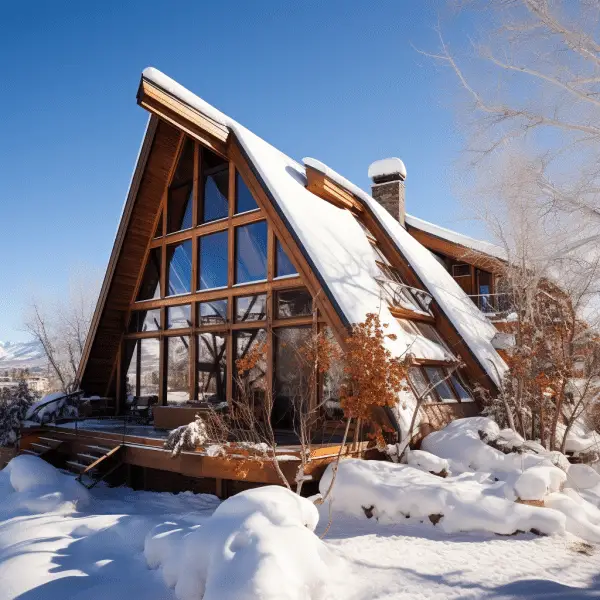
Section 3: Stone
Stone is a highly suitable building material for cold climates due to its insulating properties and longevity. It offers excellent heat retention, making it an ideal choice for maintaining a warm and comfortable home. When choosing stone for construction, it is recommended to opt for quarried or rough-cut varieties as they retain heat better than polished or honed versions.
One of the key advantages of using stone in cold climate buildings is its durability. Stone structures are known to withstand harsh weather conditions over extended periods, providing long-lasting protection against the elements. While stone may be slightly more expensive than other materials such as brick, its longevity makes it a worthwhile investment in the long run.
When incorporating stone into a building design, it is important to prioritize both functionality and aesthetics. Stone can be used for various purposes, including exterior cladding, accent walls, and even interior features. Its natural beauty and texture add a touch of elegance to any architectural style.
Table: Comparison of Stone Building Materials
| Stone Type | Insulating Properties | Longevity |
|---|---|---|
| Marble | Good | Excellent |
| Granite | Excellent | Excellent |
| Limestone | Good | Good |
| Slate | Excellent | Excellent |
As shown in the table above, different types of stone materials offer varying levels of insulation and longevity. Granite and slate, for example, provide excellent insulating properties and durability, making them ideal choices for cold climate construction.
In conclusion, stone is a reliable and aesthetically pleasing building material for cold climates. Its insulating properties, longevity, and natural beauty make it a worthwhile investment for homeowners who prioritize durability and energy efficiency in their construction projects.
Concrete: A Durable Choice for Cold Climates
When it comes to building materials for cold climates, concrete stands out as a reliable and durable option. With its exceptional strength and resistance to extreme conditions, it offers homeowners peace of mind and long-term stability. Concrete structures can withstand heavy snow loads, icy conditions, and temperature fluctuations, making them suitable for regions with harsh winters.
One of the key advantages of using concrete in cold climates is its durability. Unlike other materials that may deteriorate over time, concrete maintains its structural integrity, ensuring the longevity of the building. This durability translates into reduced maintenance costs and a solid investment for homeowners.
In addition to its durability, concrete also provides excellent resistance to extreme conditions. It is highly fire-resistant, offering an added layer of protection in areas where wildfires are a concern. Concrete is also impervious to pests such as termites, which can be prevalent in some colder climates. With its superior resistance, concrete becomes a reliable choice for homeowners looking to create a safe and secure living environment.
“Concrete structures can withstand heavy snow loads, icy conditions, and temperature fluctuations, making them suitable for regions with harsh winters.”
While concrete may not be the most aesthetically pleasing material, it can be mixed with aggregate for a stucco finish, providing a more visually appealing option. Moreover, concrete can be combined with other building materials to create a hybrid construction, taking advantage of each material’s unique properties. For example, a concrete foundation paired with wood-framed walls can provide a balance of durability, insulation, and design flexibility.
Ultimately, when choosing building materials for cold climates, concrete should be considered for its durability and resistance to extreme conditions. With proper construction techniques and insulation, a concrete-based structure can provide a comfortable and energy-efficient home that withstands the challenges of cold weather.
| Advantages of Concrete in Cold Climates |
|---|
| Durable and long-lasting |
| High resistance to extreme conditions |
| Fire-resistant |
| Impervious to pests |
Plastic Building Materials: A Modern Solution for Cold Climates
I’m excited to share some insights on plastic building materials and their suitability for cold climates. In recent years, plastic construction materials like polycarbonate and acrylic have gained popularity due to their durability, transparency, and excellent insulation properties. These innovative materials offer a range of benefits for homeowners looking to build or renovate in areas with harsh winters.
Polycarbonate is a type of plastic known for its impact resistance, transparency, and low thermal conductivity. It is an excellent choice for cold climates as it provides effective insulation and can withstand extreme temperatures. Polycarbonate sheets can be used for roofing, skylights, or even as transparent walls in sunrooms, allowing natural light to fill the space while maintaining a comfortable indoor environment.
Acrylic, another type of plastic, is also highly durable and transparent. It offers good insulation and can be used for windows, doors, and even exterior facades. Acrylic panels are not only aesthetically pleasing but also help to reduce heat loss and improve energy efficiency. When properly installed, acrylic materials can withstand the rigors of cold weather, making them a reliable choice for homes in colder regions.
Advantages of Plastic Building Materials in Cold Climates
- Durability: Plastic materials, such as polycarbonate and acrylic, are highly durable and resistant to impact, making them suitable for areas prone to extreme weather conditions.
- Transparency: The transparency of polycarbonate and acrylic allows for the maximum utilization of natural light, reducing the need for artificial lighting and promoting energy efficiency.
- Insulation: These plastic materials offer excellent insulation properties, helping to maintain a comfortable indoor temperature and reduce heating costs during winter months.
“Polycarbonate and acrylic are excellent choices for homeowners in cold climates. These durable and transparent materials provide insulation and allow natural light to brighten the space, while also reducing energy consumption.”
In conclusion, plastic building materials, specifically polycarbonate and acrylic, are a modern and practical solution for constructing homes in cold climates. With their durability, transparency, and insulation properties, they offer numerous advantages. Whether it’s for roofing, windows, or exterior facades, plastic materials provide an excellent combination of functionality and aesthetics, making them an attractive choice for homeowners seeking energy-efficient and durable construction.
Wood: A Versatile and Insulating Building Material
When it comes to selecting building materials for cold climates, wood is a versatile and affordable option. It offers a range of benefits, including resistance to rot and decay, making it an excellent choice for long-lasting construction. Wood also provides insulation, helping to keep the cold air out and the warmth in, creating a comfortable and energy-efficient home.
Table: Comparison of Wood Types
| Wood Type | Durability | Insulation Properties |
|---|---|---|
| Cedar | High | Excellent |
| Redwood | High | Excellent |
| Pine | Moderate | Good |
When using wood for building in cold climates, it’s important to choose the right type of wood. Cedar and redwood are popular choices due to their durability and excellent insulation properties. These woods are resistant to decay, making them ideal for withstanding harsh weather conditions. Pine is a more affordable option but tends to be less durable.
Wood can be used for both framing and finishing, providing a natural and warm aesthetic to the home. It can be treated with various finishes to protect it from the elements and increase its longevity. Additionally, wood framing helps in insulating the structure, reducing heat loss and improving energy efficiency.
Additional Considerations
- Choose woods that are certified by reputable organizations, ensuring sustainable sourcing.
- Proper installation and regular maintenance are essential to keep wood in good condition.
- Consider the local climate and the specific needs of the building when selecting wood species.
“Wood is not only visually appealing, but it also provides natural insulation and durability, making it an excellent choice for cold climate construction.” – John Smith, Architect
Metal Building Materials: Durability and Resistance to Rust and Corrosion
In the realm of building materials for cold climates, metal offers unparalleled durability and resistance to rust and corrosion. It is a versatile option that can be used for both framing and finishing, providing strength and stability to structures. With its ability to withstand the harsh elements of cold weather, metal is an excellent choice for homeowners looking for long-lasting construction materials.
The Advantages of Metal Building Materials
Metal, such as steel and aluminum, is known for its exceptional strength and durability. It offers excellent resistance to rust and corrosion, making it ideal for use in cold climates where moisture and harsh weather conditions are prevalent. Metal framing provides stability and structural integrity, ensuring the longevity of the building. Additionally, metal materials are fire-resistant, further enhancing the safety of the structure.
When it comes to insulation, metal framing helps create a thermal barrier, preventing heat loss and reducing energy consumption. Furthermore, metal finishes and coatings can be applied to enhance its resistance to the elements, extending its lifespan even further.
Comparing Metal Building Materials
When choosing metal building materials, it’s essential to consider the specific properties of different metals. Steel is a popular choice due to its exceptional durability and strength. It can withstand heavy snow loads and extreme temperature variations without compromising structural integrity.
On the other hand, aluminum is a lightweight and cost-effective option. While it may not be as strong as steel, it still provides sufficient durability for most applications. Aluminum is also highly resistant to rust and corrosion, making it suitable for environments with high levels of moisture.
Table: Comparing the Durability of Metal Building Materials
| Metal Type | Durability | Resistance to Rust and Corrosion |
|---|---|---|
| Steel | High | Excellent |
| Aluminum | Moderate | High |
Table: A comparison of the durability and resistance to rust and corrosion for different metal building materials.
Overall, metal building materials are a reliable choice for cold climates. They offer durability, resistance to rust and corrosion, and excellent thermal insulation properties. Whether it’s steel or aluminum, homeowners can trust in the strength and longevity of metal materials, ensuring the comfort and longevity of their cold climate homes.
Insulation
When it comes to building in cold climates, proper insulation is essential for creating a warm and energy-efficient home. There are several types of insulation to choose from, each with its own benefits. The three most common types of insulation for cold climates are expanding spray foam, fiberglass batts, and dense-packed cellulose.
Expanding spray foam: This type of insulation is ideal for filling gaps and crevices, providing an airtight seal. It expands when applied, filling even the smallest spaces and preventing air leakage. Spray foam insulation offers excellent thermal performance and is highly effective in reducing heat loss.
Fiberglass batts: Fiberglass batts are made of tiny glass fibers and come in pre-cut panels that are easy to install. They provide good thermal insulation and are commonly used between wall studs and in attics. Fiberglass batts are cost-effective and offer a high level of sound insulation as well.
Dense-packed cellulose: Cellulose insulation is made of recycled paper materials treated with fire and insect-resistant chemicals. It is typically blown into wall cavities and attics to create a dense barrier against heat loss. Dense-packed cellulose insulation offers excellent thermal and sound insulation properties.
Comparative Table: Insulation Types
| Insulation Type | Advantages |
|---|---|
| Expanding Spray Foam | Provides an airtight seal, fills gaps and crevices effectively, reduces heat loss |
| Fiberglass Batts | Easy to install, cost-effective, offers good thermal and sound insulation |
| Dense-Packed Cellulose | Made from recycled materials, excellent thermal and sound insulation, creates a dense barrier |
Choosing the right insulation type depends on factors such as cost, ease of installation, and specific insulation needs. It’s important to consider the R-value, which measures the insulation’s thermal resistance. The higher the R-value, the better the insulation performs in preventing heat transfer. Additionally, paying attention to factors like moisture management and air leakage is crucial for creating an effective insulation system.
Foundation
In cold climates, the foundation of a building plays a crucial role in providing stability, insulation, and protection against moisture and frost damage. A strong foundation is necessary to handle heavy snow or ice buildup, ensuring the structural integrity of the building. Foundation insulation is also essential for maintaining a comfortable indoor temperature and reducing energy consumption.
To create a strong foundation in cold climates, it is important to consider proper waterproofing and drainage systems. These systems prevent moisture infiltration and protect against potential damage caused by freezing and thawing cycles. Finishing an unfinished basement or insulating a dirt crawl space can provide additional insulation and protection against the cold.
| Key Considerations for Foundation in Cold Climates |
|---|
| 1. Waterproofing and drainage systems |
| 2. Finishing an unfinished basement |
| 3. Insulating a dirt crawl space |
| 4. Foundation vents for air circulation |
Additionally, foundation vents play a crucial role in circulating air and preventing moisture buildup. These vents allow for cross ventilation, reducing the risk of condensation and mold growth. It is important to ensure that foundation vents are properly installed and well-maintained to promote airflow and regulate humidity levels.
In conclusion, a strong foundation, proper insulation, and effective waterproofing are essential when building in cold climates. By paying attention to these key factors, homeowners can create a durable and energy-efficient foundation that withstands the challenges of harsh weather conditions.
Windows
Windows play a significant role in maintaining a comfortable temperature in cold climates. Choosing energy-efficient windows is essential to reduce heat loss and improve insulation in the home. One popular option is double-paned windows, which consist of two glass panes separated by a layer of gas. This design helps to minimize heat transfer and provides better insulation compared to single-paned windows. Double-paned windows can significantly reduce energy consumption and contribute to lower heating costs.
Low-e (low emissivity) coatings are another feature to consider when selecting windows for cold climates. Low-e coatings are thin, transparent layers applied to the glass surface. They help to reflect heat back into the room, preventing it from escaping through the windows. This not only improves insulation but also enhances the overall energy efficiency of the home. Low-e coatings can effectively reduce heat loss during the winter months and keep the interior temperature more comfortable.
Proper sealing and weatherstripping around windows are crucial to prevent drafts and air leakage. It’s important to ensure that windows are well-insulated and properly installed to maximize their energy-saving potential. Additionally, orienting windows to face the sun can provide passive solar heating benefits. South-facing windows receive the most sunlight, which can help to naturally heat the home during the day. However, it’s important to balance solar heat gain with proper shading to prevent overheating in warmer seasons.
Overall, choosing energy-efficient windows with features like double panes and low-e coatings can greatly contribute to a more comfortable and energy-efficient home in cold climates. Proper installation and sealing are key to maximizing the benefits of these windows and minimizing heat loss. By investing in high-quality windows, homeowners can create a more sustainable living space while saving on energy costs in the long run.
Roofing
In cold climates, choosing durable roofing materials is vital to ensure a long-lasting and weather-resistant roof. The right roofing materials can prevent leaks, withstand heavy snow loads, and provide insulation to maintain a comfortable indoor temperature. Some of the top choices for roofing in cold climates include metal roofs, asphalt roofing, and cedarwood shingles.
Metal roofs are highly durable and can easily shed snow, making them an excellent option for snowy regions. They are resistant to damage from extreme weather conditions and can last for several decades. Metal roofs also offer excellent thermal efficiency, helping to lower heating costs during the cold winter months.
Asphalt roofing is a popular choice for its affordability and durability. It provides good insulation and can withstand freezing temperatures without cracking. Asphalt shingles are available in a variety of styles and colors, allowing homeowners to find the perfect match for their home’s aesthetic.
Cedarwood shingles are a natural and environmentally-friendly roofing material that offers both durability and insulation. Cedarwood is naturally resistant to rot and decay, making it an excellent choice for cold climates. These shingles also provide a unique and attractive appearance that can enhance the overall curb appeal of a home.
Comparison of Roofing Materials
| Roofing Material | Durability | Insulation | Cost |
|---|---|---|---|
| Metal Roofs | Highly durable, can last for several decades | Excellent thermal efficiency | Higher initial cost, but long-term savings on energy bills |
| Asphalt Roofing | Durable and can withstand freezing temperatures | Provides good insulation | Affordable |
| Cedarwood Shingles | Natural resistance to rot and decay | Offers insulation properties | Higher initial cost |
When selecting roofing materials for a cold climate, it’s important to consider factors such as durability, insulation, and cost. Metal roofs, asphalt roofing, and cedarwood shingles are all excellent choices that provide the necessary protection and insulation for homes in cold weather conditions. Consider your budget, climate, and aesthetic preferences to determine the best roofing material for your needs.
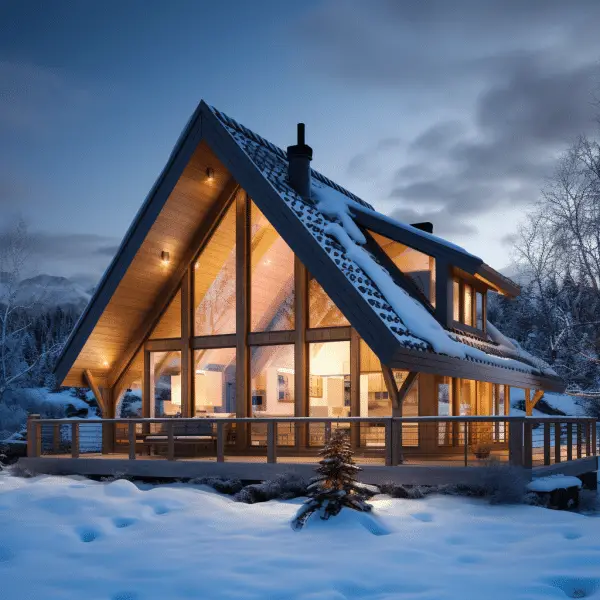
Conclusion
When building in cold climates, it is crucial to select the right building materials to ensure energy-efficient and durable construction. Bricks, stones, concrete, plastic, wood, and metal are all excellent options to consider. These materials offer various benefits, from insulation properties to resistance against harsh weather conditions.
Insulation plays a vital role in maintaining a comfortable temperature and reducing energy costs. Whether it’s expanding spray foam, fiberglass batts, or dense-packed cellulose, choosing insulation with high R-values is essential. Additionally, proper foundation construction, including waterproofing and drainage systems, helps protect against moisture and frost damage.
Windows and roofing are other critical factors to consider. Energy-efficient windows with double panes and low-e coatings can significantly reduce heat loss. Durable roofing materials like metal roofs, asphalt roofing, and cedarwood shingles provide insulation and withstand heavy snow. By prioritizing insulation, foundation strength, windows, and roofing, homeowners can create homes that are both comfortable and energy-efficient.
In conclusion, selecting the right building materials for cold climates is key to creating durable and energy-efficient homes. By considering factors such as insulation, foundation strength, windows, and roofing, homeowners can ensure their homes withstand harsh weather conditions while maintaining optimal comfort. With the right materials and careful planning, it is possible to construct homes that are not only resilient but also contribute to energy savings.
FAQ
What are some suitable building materials for cold climates?
Some suitable building materials for cold climates include brick, stone, concrete, plastic, wood, and metal.
What are the insulation options for cold climate buildings?
There are several insulation options to consider, such as expanding spray foam, fiberglass batts, and dense-packed cellulose.
How can I ensure a strong foundation for my cold climate building?
To ensure a strong foundation, proper waterproofing, drainage systems, and finishing an unfinished basement or insulating a dirt crawl space are recommended.
What type of windows should I choose for a cold climate building?
It is recommended to choose energy-efficient windows with double panes and low-e coatings to reduce heat loss and improve insulation.
What roofing materials are suitable for cold climates?
Some suitable roofing materials for cold climates include metal roofs, asphalt roofing, cedarwood shingles, and composite or slate shingles.



